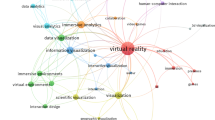Abstract
This article is based on an analysis about the understanding of the visualization and spatial projection directed toward students of higher education. This one describes the experience acquired with the course of Descriptive Geometry and it implements in the use of the technology in the spatial projection, which is directed to students of first and second semester of the careers of architecture and industrial design. Its aim is to learn to develop skills for the understanding of visual perception and spatial expression, under systems of parallel and conical projection in the construction of objects and spaces. The present work was realized with the objective so that the student can better understand the spatial sense for the constructive visual representation. Therefore, the use of technology is established through virtual reality and augmented reality, but with the difference that these representations must help the construction of three-dimensional models with the use of laser cutting systems. Considering previous, basic aspects since it is to determine a system of units, scales or coordinates (length, width and thickness) they go jointly so much in the manual representation as the foxglove. The intention to introduce the use of augmented reality is to locate the student any object represented in a given space. Also, with the introduction of the physical construction in laser cut, the student will confirm the result by itself of the work that he realized. To do this, a user-friendly software is chosen that is easy to acquire, such as SketchUp for rendering in Virtual Reality and Augmented Reality, as well as the compatibility of this software with others such as the autocad or illustrator to send the information to the three-dimensional construction in laser, ready for the final presentation. All this synergy in which the work whit instruments by hand is combined with digital systems is done through an interaction design. We are not very accustomed to seeing it in this field of action, but this is a sample of what is done with this process of work.











Source: Luis Fernando de la Garza Benavides and Bianca Janeth Gonzalez Luna, of \(9^{\mathrm{o}}\) semester student of the career of architecture Monterrey (2016)
Similar content being viewed by others
References
Aguilera González, N.A.: La Educación Visual en la Sociedad del Conocimiento. Thesis doctoral degree. CEMARTH. RVOE: AD-I 113/2011. Monterrey (2014) [ISBN 03-2015-011212534500-01] (pp. 109–169)
Bertol, D., Foell, D.: Designing Digital Space. An Architect’s Guide To Virtual Reality. pp. 4-19–44-72. John Wiley, New York. ISBN 0-471-14662-5 (1997)
Dziekonski, M.: Space Intelligence. A Look at Howard Gardner. ARTEOFICIO Journal No. 2. University of Santiago de Chile. School of Architecture \(\text{N}^{{\rm o}}\) pp. 7–12, 116018. ISSN 0717–5590 (2003)
Ching, Francis D.K.: Architecture Form, Space & Order. In: Gili, G. (ed.) pp. 70–71. Spain, ISBN: 968-887-340-3 (1998)
Ching, F.D.K.: Design Drawing. In: Gili, G. (ed.), pp. 124–129. Spain, ISBN: 84-252-2081-5 (2005)
Eisner, E.W.: Art and the Creation of Mind: The Role of Visual Arts in the Transformation of Consciousness. In: Paidós (ed.), pp. 21–22. Spain, ISBN 84-493-1519-0 (2004)
Gardner, H.: Structures of the Mind, pp. 138–161. Fondo de Cultura Económica, Colombia. ISBN 0-465-02510-2 (2001)
Nivoliers, V., Yan, D., Lévy, B.: Fitting Polynomial Surfaces to Triangular Meshes with Voronoi Squared Distance Minimization. Engineering with Computers Journal (Vol. 30, Issue 3, pp. 289–300) Springer, London. Special Issue: \(20{{\rm th}}\) International Meshing Roundtable, ISSN: 0177-0667 (Print) 1435-5663 (Online). doi:10.1007/s00366-012-0291-9 (2012)
Ráfols, R., Colomer, A.: Audiovisual Design. In: Gili, G. (ed.), pp. 29–31. Spain, ISBN: 84-252-1538-2 (2010)
Rogers, Y., Winograd, T.: Interaction Design. Beyond Human–Computer Interaction, pp. 1–2. Wiley, New York. ISBN 0-471-49278-7 (2002)
Uddin, M.S.: Axonometric and Oblique Drawing: A 3-D Construction, Render, pp. 11–15. Mc-Graw Hill, New York. ISBN 0-07-065755-6 (1997)
Wong, W.: Principles of Form and Design. In: Gili, G. (ed.), p. 59. Spain, ISBN: 84-252-1643-5 (2005)
Acknowledgements
To my assistants, Luis Fernando de la Garza Benavides and Bianca Janeth Gonzalez Luna, students of \(9 ^{\mathrm{o}}\). Semester of the Plan 2011 of the career of Architecture at ITESM Campus Monterrey. Thanks to this great team I am carrying out this work of investigation, which is the beginning of more material of work.
To Fernando Suárez-Warden, Ph.D.
Author information
Authors and Affiliations
Corresponding author
Rights and permissions
About this article
Cite this article
González, N.A.A. Development of spatial skills with virtual reality and augmented reality. Int J Interact Des Manuf 12, 133–144 (2018). https://doi.org/10.1007/s12008-017-0388-x
Received:
Accepted:
Published:
Issue Date:
DOI: https://doi.org/10.1007/s12008-017-0388-x




